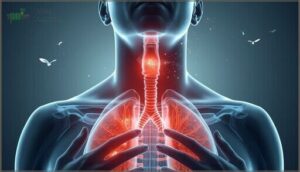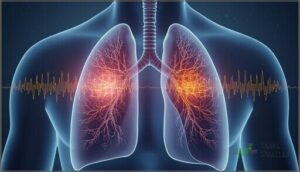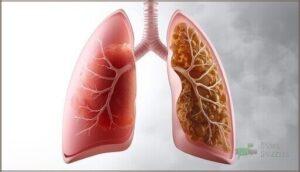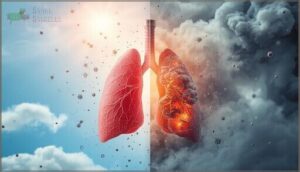This site is supported by our readers. We may earn a commission, at no cost to you, if you purchase through links.

Behind every stubborn cough or wheeze, your body may be signaling for help. Spotting those signals early, knowing which warnings mean trouble, can make all the difference between catching a minor problem and facing a major health crisis.
Table Of Contents
- Key Takeaways
- Common Signs of Respiratory Issues
- Warning Signs of Severe Respiratory Distress
- Causes of Respiratory Symptoms
- Signs of Respiratory Issues in Children
- When to Seek Medical Attention
- Frequently Asked Questions (FAQs)
- What are the symptoms of a respiratory disease?
- What are the symptoms of Acute respiratory distress syndrome?
- How do you know if you have respiratory distress?
- How do you know if you have respiratory failure?
- What are the signs & symptoms of respiratory distress in children?
- How do you know if a person has trouble breathing?
- How do you know if you have respiratory issues?
- What happens when someone goes into respiratory distress?
- How to quickly get rid of an upper respiratory infection?
- When should I see a doctor about a respiratory illness?
- Conclusion
Key Takeaways
- Chronic respiratory symptoms like a cough lasting over eight weeks, persistent shortness of breath, wheezing, or daily mucus production aren’t minor annoyances—they signal underlying conditions such as asthma, COPD, or chronic lung disease that require medical evaluation before they escalate.
- Severe warning signs including labored breathing with visible chest retractions, blue-tinged skin (cyanosis), coughing up blood, confusion, or loss of consciousness demand immediate emergency care because they indicate dangerous oxygen deprivation that can cause organ damage within minutes.
- Children show respiratory distress differently than adults through physical signs like nasal flaring, grunting sounds, using neck and chest muscles to breathe, refusing to feed, or unusual lethargy—signals parents must recognize quickly since kids can’t always communicate what’s wrong.
- Don’t wait to seek medical attention if respiratory symptoms persist beyond one month, worsen suddenly, or include chest pain and bloody sputum—early intervention prevents minor problems from becoming life-threatening crises, especially since conditions like pneumonia and tuberculosis require prompt diagnosis and treatment.
Common Signs of Respiratory Issues
Your body sends clear signals when something’s wrong with your respiratory system. Some symptoms develop slowly over time, while others appear suddenly and demand immediate attention.
Here are the most common signs that your lungs or airways need medical evaluation.
Chronic Cough
Often overlooked as “just a cough,” chronic cough lingers for more than eight weeks and signals underlying issues—not mere annoyance. With global prevalence ranging from 2.5% to 18% among adults, this respiratory symptom stems from etiological factors like asthma, reflux, or airway inflammation.
Diagnostic evaluation helps your healthcare provider pinpoint causes, while emerging trends recognize the cough’s quality-of-life impact: sleep disruption, social withdrawal, and exhaustion demand attention. Chronic cough may also be caused by iatrogenic ACE inhibitors.
Persistent Shortness of Breath
Persistent shortness of breath—dyspnea lasting beyond four weeks—affects roughly 10% of adults and shouldn’t be dismissed as “getting older.” Women report this symptom 33% more often than men. Underlying conditions include asthma (25% of cases), heart disease (30%), and obesity (43%).
You might notice reduced activity tolerance or air hunger from ventilation mismatch. This breathing difficulty signals physiological mechanisms requiring evaluation, especially since chronic dyspnea increases cardiac risk over time.
Patient self-reporting is the only reliable way to identify chronic breathlessness.
Wheezing and Noisy Breathing
Wheezing—that high-pitched whistling you hear when breathing—signals narrowed airways, often from asthma affecting 25 million Americans or COPD. You’ll notice it during exhalations as airway resistance increases up to fivefold.
Stridor, a harsh inspiratory sound, indicates upper airway narrowing, especially in children with croup.
Don’t ignore persistent noisy breathing; it predicts 18% higher hospitalization rates and reduced lung function over time.
Chronic Mucus Production
If you’re coughing up thick sputum day after day, pay attention to changes in Sputum Consistency or Mucus Color. Chronic mucus production—especially in smokers—can signal early respiratory disease symptoms or chronic lung conditions like COPD.
Hypersecretion Prevalence climbs with age, and it’s linked to declining Lung Function. Treatment options depend on your specific Lung disease.
Chest Pain or Tightness
You might mistake chest pain for a heart issue, but respiratory origins account for over 36% of acute chest cases in emergency departments. Chest tightness during deep breaths or coughing—known as pleuritic pain—often signals lung disease like pneumonia or a collapsed lung.
Pain exacerbation with movement separates pulmonary problems from cardiac ones. Your healthcare provider will use diagnostic imaging to pinpoint the cause and guide treatment.
Coughing Up Blood
When should a small streak of blood in your sputum ring alarm bells? Coughing up blood—medically termed hemoptysis—demands immediate evaluation, as lung cancer accounts for nearly 23% of cases, while tuberculosis and bronchiectasis explain another third.
Coughing up blood demands immediate evaluation—lung cancer accounts for nearly 23% of cases
Your diagnostic pathway includes:
- Chest imaging to locate the bleeding source
- Bronchoscopy for direct airway visualization
- CT angiography when initial tests prove inconclusive
Severity levels range from minor streaking to life-threatening massive hemoptysis requiring urgent intervention.
Warning Signs of Severe Respiratory Distress
Some respiratory symptoms aren’t just uncomfortable—they’re red flags that your body is struggling to get enough oxygen. These warning signs mean you need medical help right away, not tomorrow or next week.
Recognizing these urgent symptoms can make the difference between a manageable situation and a life-threatening emergency.
Labored or Difficult Breathing
When your chest works overtime just to pull in air, that’s labored breathing—clinically known as dyspnea—and it demands immediate attention. You’ll notice visible retractions around your ribs or collarbone, rapid breathing exceeding 20 breaths per minute, or clammy, bluish skin. This respiratory distress affects approximately 8.9% of emergency department visits, with infants and elderly patients facing the highest risk.
Geriatric considerations are key—those over 75 account for 65.5 emergency visits per 100 people annually. Children face different challenges because their narrower airways make breathing difficulties more dangerous, leading to nasal flaring and feeding problems. Don’t wait if you’re experiencing these symptoms; 42% of patients with dyspnea require hospital admission, and 8.1% need intensive care.
| Clinical Sign | What You’ll Notice | When It Matters Most |
|---|---|---|
| Tachypnea | Breathing faster than 20 times per minute | Emergency treatment needed; signals severe distress |
| Visible Retractions | Chest pulls in sharply around ribs during breathing | Common in pediatric dyspnea; indicates airway obstruction |
| Oxygen Levels | PaO2 below 70 mm Hg or low saturation | Clinical measurements guide disease correlation decisions |
Severe Shortness of Breath After Minimal Activity
When climbing stairs leaves you gasping as if you’ve run a marathon, you’re experiencing exertional dyspnea—a red flag that shouldn’t be ignored. This shortness of breath after minimal activity signals ventilatory exhaustion and functional limitations that double your mortality risk.
Cardiac comorbidities often lurk beneath breathing difficulties, making assessment tools like the mMRC scale essential for tracking respiratory distress. Oxygen deprivation during simple tasks constitutes a medical emergency requiring immediate evaluation.
Pale or Blue-Tinged Skin (Cyanosis)
When your lips or fingertips take on a bluish tint, you’re witnessing cyanosis—visual proof that your oxygen saturation has dropped below 85%. This discoloration appears when hemoglobin levels can’t meet your body’s oxygen demands, signaling severe respiratory distress.
Central cyanosis affects your:
- Lips and tongue
- Mucous membranes inside your mouth
- Nail beds and fingertips
- Areas where skin is naturally thin
Peripheral cyanosis generally shows up in your extremities first. Diagnostic methods like pulse oximetry confirm dropping oxygen levels, but don’t wait for testing—visible cyanosis demands immediate medical attention to prevent organ damage.
Confusion or Fatigue
When your brain feels foggy or your body can’t shake overwhelming tiredness, your respiratory system might be struggling to deliver adequate oxygen. These cognitive impacts signal hypoxia’s effect on your mental clarity and physical stamina—early indicators that shouldn’t be ignored.
Breathing problems that rob your brain of oxygen manifest as difficulty concentrating, disorientation, or exhaustion that persists despite rest. If you notice shortness of breath paired with mental fog or crushing fatigue, contact your healthcare provider promptly—these respiratory symptoms often precede serious complications requiring escalated care.
| Symptom Category | Prevalence | Clinical Significance |
|---|---|---|
| Confusion in acute respiratory failure | 20–50% of cases | Indicates severe hypoxemia requiring immediate evaluation |
| Fatigue in COPD patients | 59–72% globally | Predicts hospitalization and reduced quality of life |
| Cognitive impairment post-ARDS | 36% at 6 months | Reflects persistent executive dysfunction |
| Combined confusion and fatigue | 27–46% post-ARDS | Signals need for supplemental oxygen in 60% of cases |
| Fatigue duration post-critical illness | 66–70% at 12 months | Correlates with exercise intolerance and mortality risk |
Loss of Consciousness
If you pass out during breathing trouble, your body’s screaming for help—oxygen deprivation (hypoxia) can trigger unconsciousness in seconds. Severe respiratory distress may cause CO₂ narcosis or respiratory syncope, where inadequate gas exchange leads to neurological damage.
This medical emergency demands immediate airway obstruction assessment and brain monitoring. Never dismiss fainting paired with breathing problems; hypoxia effects worsen rapidly without intervention.
Causes of Respiratory Symptoms
Your respiratory symptoms don’t appear out of nowhere—they’re your body’s way of signaling that something’s interfering with normal lung function. Understanding what triggers these warning signs helps you recognize patterns and take action before problems escalate.
Let’s look at the main culprits behind respiratory symptoms, from chronic diseases to environmental threats.
Chronic Respiratory Diseases (Asthma, COPD, Pulmonary Fibrosis)
Among chronic respiratory conditions, three illnesses stand out for their frequency and impact on daily life. Understanding them can help you recognize warning signs early and seek appropriate care:
- Asthma: Affects over 37 million people worldwide. You’ll experience airway inflammation causing shortness of breath, wheezing, and chest tightness. Asthma management focuses on controlling symptoms and preventing flare-ups.
- COPD: This progressive disease impacts more than 400 million globally, primarily from smoking. COPD exacerbations worsen breathlessness and cough, often requiring hospitalization.
- Pulmonary fibrosis: Scarred lung tissue reduces your breathing capacity. Fibrosis progression shows through declining lung function tests, with forced capacity dropping below 80% in symptomatic patients.
- Disease prevention: Quitting smoking and avoiding pollutants remain your strongest defenses. Pulmonary rehab programs combine exercise and education to improve outcomes for all three conditions.
Lung Infections (Pneumonia, Tuberculosis)
While chronic diseases develop slowly, lung infections strike with urgency. Pneumonia mortality claimed over 2.1 million lives in 2021, hitting hardest in children under five and adults over seventy. Tuberculosis transmission occurs through airborne droplets—just talking with someone infected can spread it. You’ll notice a persistent cough lasting beyond three weeks, fever, and night sweats with TB. Pediatric pneumonia sends kids to hospitals five times more often than older children, especially in TB-endemic regions.
| Infection Type | Key Warning Signs |
|---|---|
| Pneumonia | Fever, productive cough, chest pain worsening with breathing |
| Tuberculosis | Cough >3 weeks, blood-tinged sputum, unexplained weight loss |
| Pediatric Pneumonia | Rapid breathing, chest retractions, refusal to feed |
| Diagnostic Indicators | Elevated neutrophil-to-lymphocyte ratio, abnormal chest X-ray |
| Treatment Costs | Average $847 per TB case; up to 61% face catastrophic expenses |
Diagnostic indicators like chest X-rays and sputum tests confirm these infectious agents. Treatment costs for tuberculosis average $847 but can devastate household budgets—many families sell possessions just to afford care. Early recognition of respiratory infections saves lives and wallets.
Environmental Factors (Smoking, Pollution)
Infections aren’t the only threat—what you breathe daily matters just as much. Tobacco deaths reach 490,000 annually in the U.S., causing 85–90% of COPD cases. Air pollution accelerates lung decline, with urban pollution exposing you to PM₂.₅ levels six times WHO limits. Secondhand smoke triggers 150,000–300,000 infant respiratory infections yearly.
Combined risks multiply: smoking plus air pollutants increase chronic lung disease risk 2.5-fold. Your environment shapes your respiratory health.
Genetic and Other Predispositions
Beyond environmental exposures, your DNA plays a key role in lung disease causes. Family history contributes 18.6% of COPD risk, while genetic correlations between asthma and COPD reach 0.70.
Key genetic factors include:
- Familial COPD risk – siblings face 5.8 times higher odds
- Sex-linked genes – males inherit greater risk for childhood asthma
- Common variants – present in 5%+ of populations
- Ethnic disparities – earlier disease onset in minority groups
Signs of Respiratory Issues in Children
Children can’t always tell you when something feels wrong with their breathing, which makes recognizing the physical signs important for parents and caregivers. Their respiratory systems work differently than adults’, so the warning signs often show up in unique ways that you need to watch for carefully.
Here are the key respiratory distress signals that require your immediate attention in children.
Nasal Flaring
When your child’s nostrils flare with each breath, it’s a red flag you shouldn’t ignore. Nose flaring appears in about 12% of children with respiratory distress and signals difficulty breathing that demands immediate attention.
This visible sign of respiratory distress often accompanies lower oxygen levels and appears more frequently as severity increases. Clinical guidelines recognize nasal flaring as a key indicator for escalating care—particularly in neonatal distress situations where diagnostic accuracy helps determine treatment urgency.
Use of Chest or Neck Muscles to Breathe
When you notice your child’s neck muscles tightening or their ribs pulling inward with each breath, you’re witnessing accessory muscle function—a diagnostic muscle indicator of respiratory distress. This pediatric distress sign appears in over 90% of severe COPD exacerbations and signals respiratory muscle fatigue.
Difficulty breathing that forces chest wall retractions reflects dangerous shortness of breath requiring immediate evaluation—these warning signs often coincide with oxygen levels dropping below 90%.
Grunting or Wheezing Sounds
Your child’s breathing sounds can tell you a lot about their lung health. Infant grunting—a low expiratory noise from rapid glottis closure—and pediatric wheezing indicate respiratory distress requiring diagnostic evaluation.
Wheezing affects nearly 40% of children by age three, often signaling early warning signs of lung disease like asthma. Sound analysis helps clinicians assess severity, making these symptoms of respiratory illness critical diagnostic indicators you shouldn’t ignore.
Refusal to Feed or Lethargy
When your baby refuses to eat or seems unusually drowsy, you’re witnessing early warning signs of lung disease. Feeding difficulty appears in 3% of pediatric respiratory emergencies, while lethargy was reported in 71% of confirmed respiratory infections.
This hypoxia-lethargy link occurs because increased breathing effort depletes energy. Premature infants face feeding aspiration risks that worsen respiratory distress, demanding immediate attention from your healthcare provider before hospitalization trends escalate.
When to Seek Medical Attention
Knowing when to call your doctor can make all the difference if you’re dealing with breathing problems. Certain signs should never be ignored, no matter how mild they seem.
Here’s what to watch for and what to bring with you if it’s time for a visit.
Symptoms Lasting Longer Than One Month
If your cough, shortness of breath, or wheezing lingers past a month, it’s not just a nuisance—it’s a red flag. Chronic cough prevalence sits around 5% in adults, and post-COVID symptoms often persist for months, impacting your quality of life.
Persistent symptoms signal underlying risk factors and drive up healthcare utilization, so don’t ignore them.
Sudden or Severe Breathing Problems
If your breathing suddenly worsens or you feel like you can’t catch your breath, that’s a medical emergency. Emergency dyspnea, rapid ARDS incidence, and cyanosis signs—like blue lips—signal severe respiratory distress. You may notice:
- Difficulty breathing at rest
- Shortness of breath within minutes
- Use of neck muscles
- Rapid heart rate
- Psychological impact, such as fear
Coughing Up Blood or Chest Pain
If you spot blood in your sputum—what we call hemoptysis—or feel chronic chest pain, don’t wait it out. These symptoms often point to serious underlying issues, from bronchiectasis to lung cancer.
Severity indicators like coughing up more than a teaspoon of blood or chest pain with breathing demand immediate emergency assessment and clinical management by a healthcare provider.
Preparing Information for Your Doctor
When symptoms like chest pain or hemoptysis send you to the doctor, preparation matters. Symptom documentation—tracking cough, breathlessness, and triggers—helps your healthcare provider see patterns.
Bring updated medication records and contextual information, including your medical history and recent data collection (like oxygen readings).
Effective communication means sharing how symptoms affect daily life, making your doctor’s visit more productive.
Frequently Asked Questions (FAQs)
What are the symptoms of a respiratory disease?
Funny how a tickle in your throat one week can turn into relentless coughing, wheezing, or labored breathing the next.
Early symptoms of respiratory disease often progress—overlapping signs like persistent cough, chest pain, or fatigue can impact quality of life.
What are the symptoms of Acute respiratory distress syndrome?
Early ARDS often brings severe respiratory distress, rapid shallow breathing, and low oxygen levels (hypoxemia). You may notice bluish lips, chest pain, confusion, and fatigue.
Radiological findings, organ involvement, and biomarker abnormalities help confirm respiratory failure.
How do you know if you have respiratory distress?
You’ll know you’re facing respiratory distress when breathing becomes labored, rapid, or noisy, or you notice severe shortness of breath, cyanosis, or confusion.
Home monitoring tools like pulse oximeters help track severity indicators—act quickly if symptoms worsen.
How do you know if you have respiratory failure?
Ever wondered if your breathing problems are more than just a bad day? Respiratory failure shows up as confusion, rapid breathing, low oxygen saturation, and ABG Interpretation revealing hypoxemia signs or hypercapnia effects—these distress indicators demand early detection and prompt action.
What are the signs & symptoms of respiratory distress in children?
Watch for nasal flaring, grunting sounds, skin changes like pallor or cyanosis, rapid breathing (tachypnea rates), use of accessory muscles, and wheezing.
These signs of respiratory distress signal breathing problems that need prompt medical attention.
How do you know if a person has trouble breathing?
Trouble breathing often shows up as rapid or shallow breaths, pale or blue-tinged skin, confusion, and fatigue. You might notice increased respiratory rate changes, drops in oxygen saturation levels, and other symptoms of respiratory distress.
How do you know if you have respiratory issues?
Breathing easy isn’t always a given—early indicators like chronic cough, wheezing, or chest tightness can sneak up.
Symptom tracking and home monitoring help you spot respiratory symptoms, assess severity, and understand lifestyle impact before distress sets in.
What happens when someone goes into respiratory distress?
When someone enters respiratory distress, you’ll notice rapid breathing, labored effort, and possible blue skin—signs of oxygen deprivation and airway obstruction.
Clinical distress signs progress quickly, impacting organ systems and leading to medical emergencies if not recognized early.
How to quickly get rid of an upper respiratory infection?
Most upper respiratory infections resolve on their own within 7-10 days. Early treatments like rest, hydration, and symptom relief with over-the-counter medications help. Antibiotics don’t work for viral infections—consult your healthcare provider if symptoms worsen.
When should I see a doctor about a respiratory illness?
You should seek medical advice if your respiratory symptoms persist beyond three weeks, worsen suddenly, or include alarming signs like coughing up blood, severe chest pain, oxygen saturation below 92%, or difficulty breathing.
Conclusion
Your lungs are like sentries standing watch—silent until something goes wrong. Recognizing the signs of respiratory issues early gives you the power to act before minor symptoms escalate into serious complications.
A persistent cough, unexplained breathlessness, or chest tightness shouldn’t be dismissed as fleeting inconveniences. Trust what your body tells you. If symptoms persist beyond a few weeks or worsen suddenly, don’t wait. Seek medical attention and give your lungs the care they deserve.
- https://pmc.ncbi.nlm.nih.gov/articles/PMC10183506/
- https://jtd.amegroups.org/article/view/100654/html
- https://www.sciencedirect.com/science/article/pii/S2589537024000026
- https://www.who.int/health-topics/chronic-respiratory-diseases
- https://www.cosinuss.com/en/measured-data/vital-signs/respiration-rate/
















